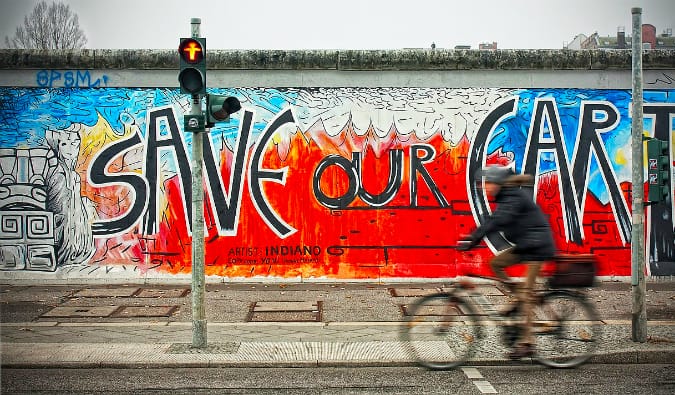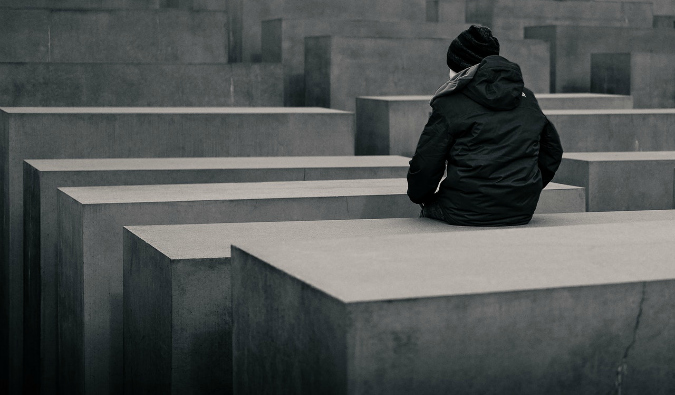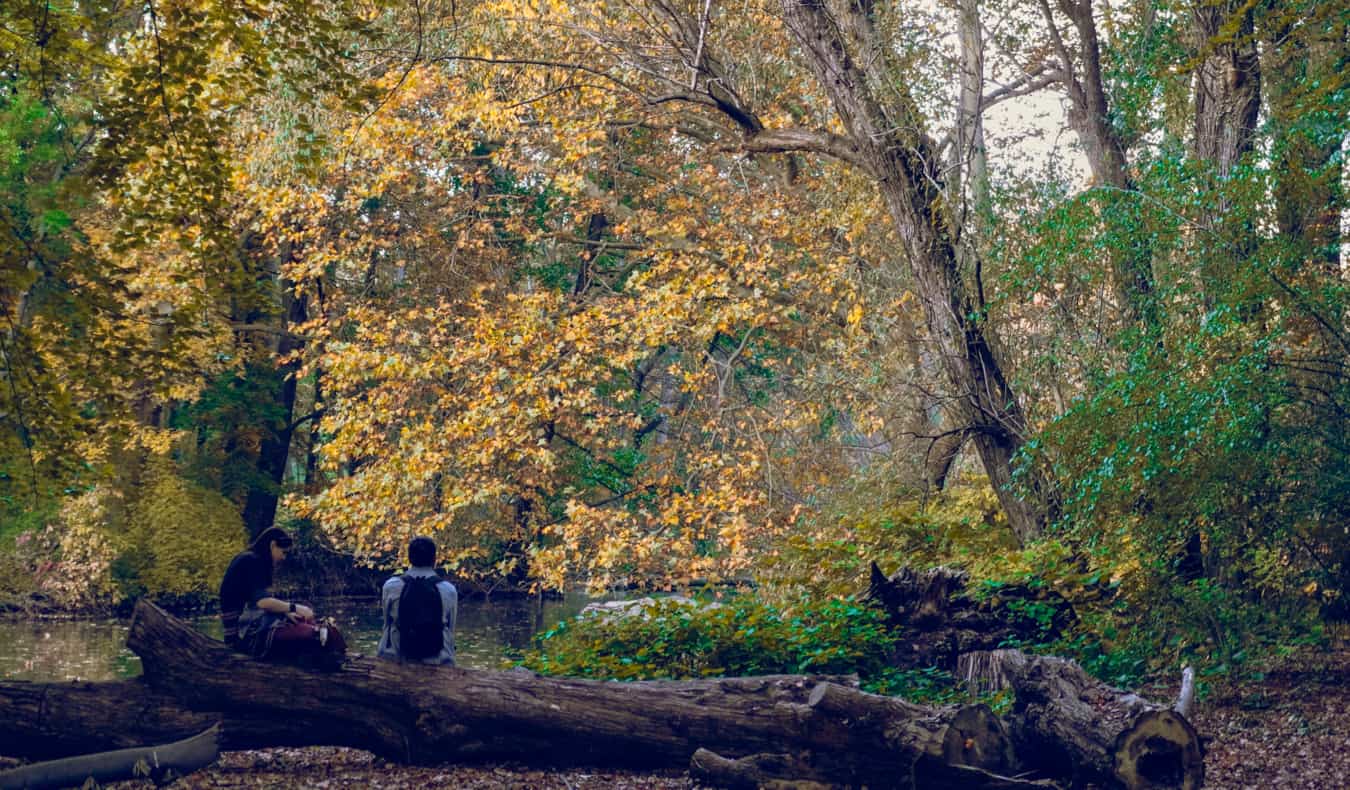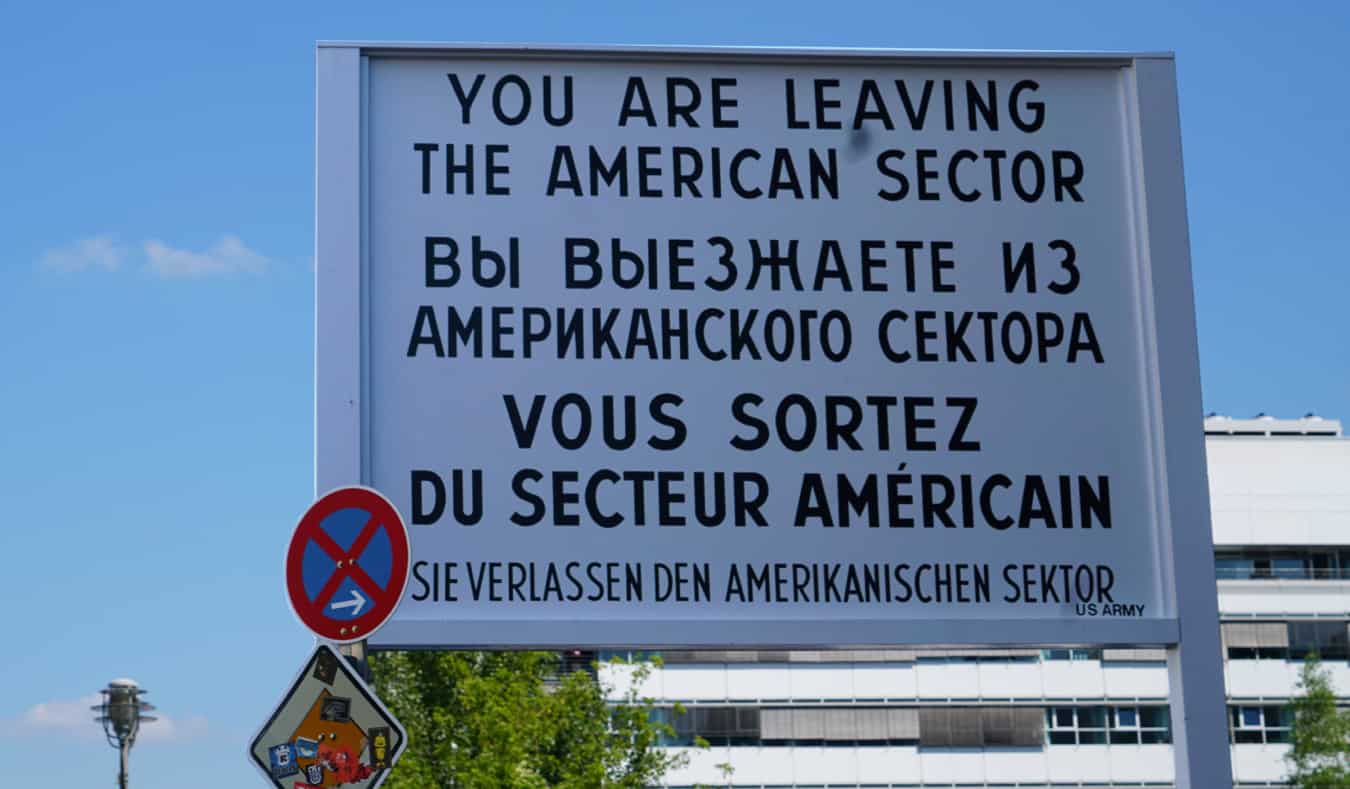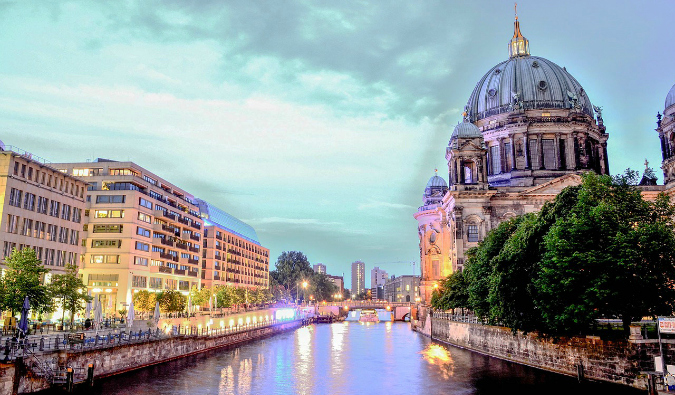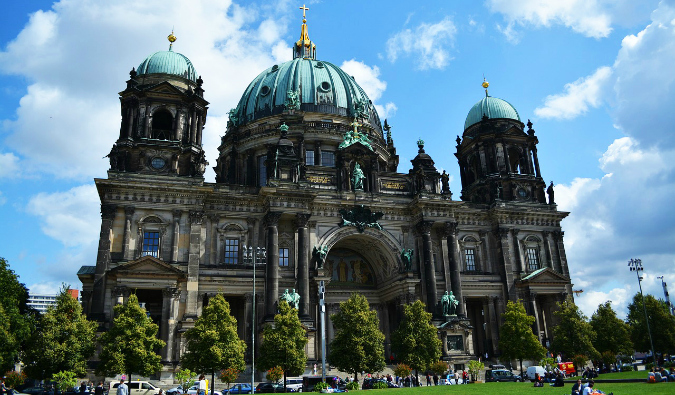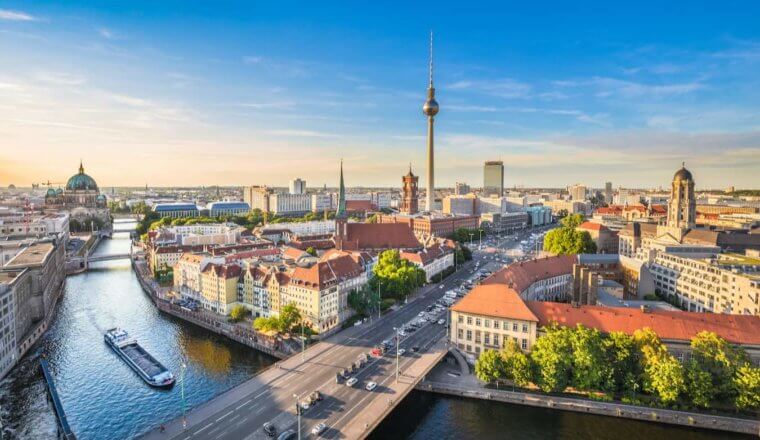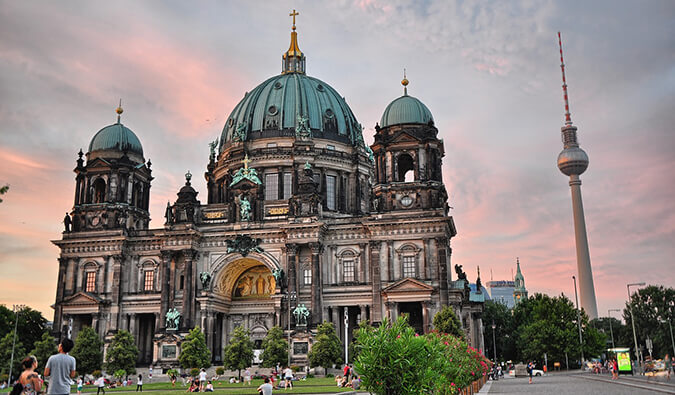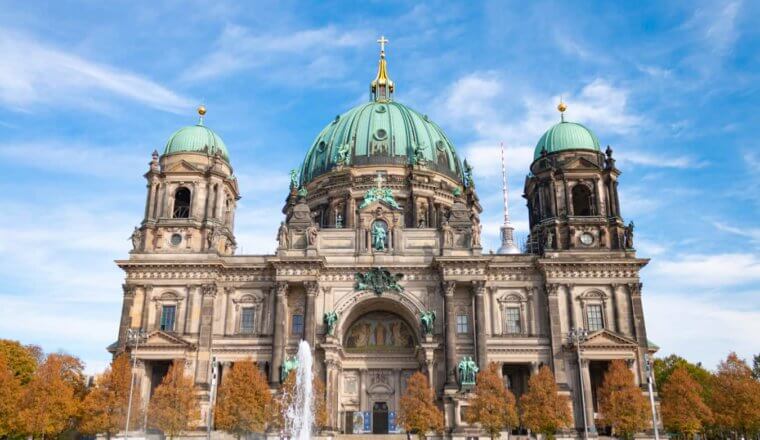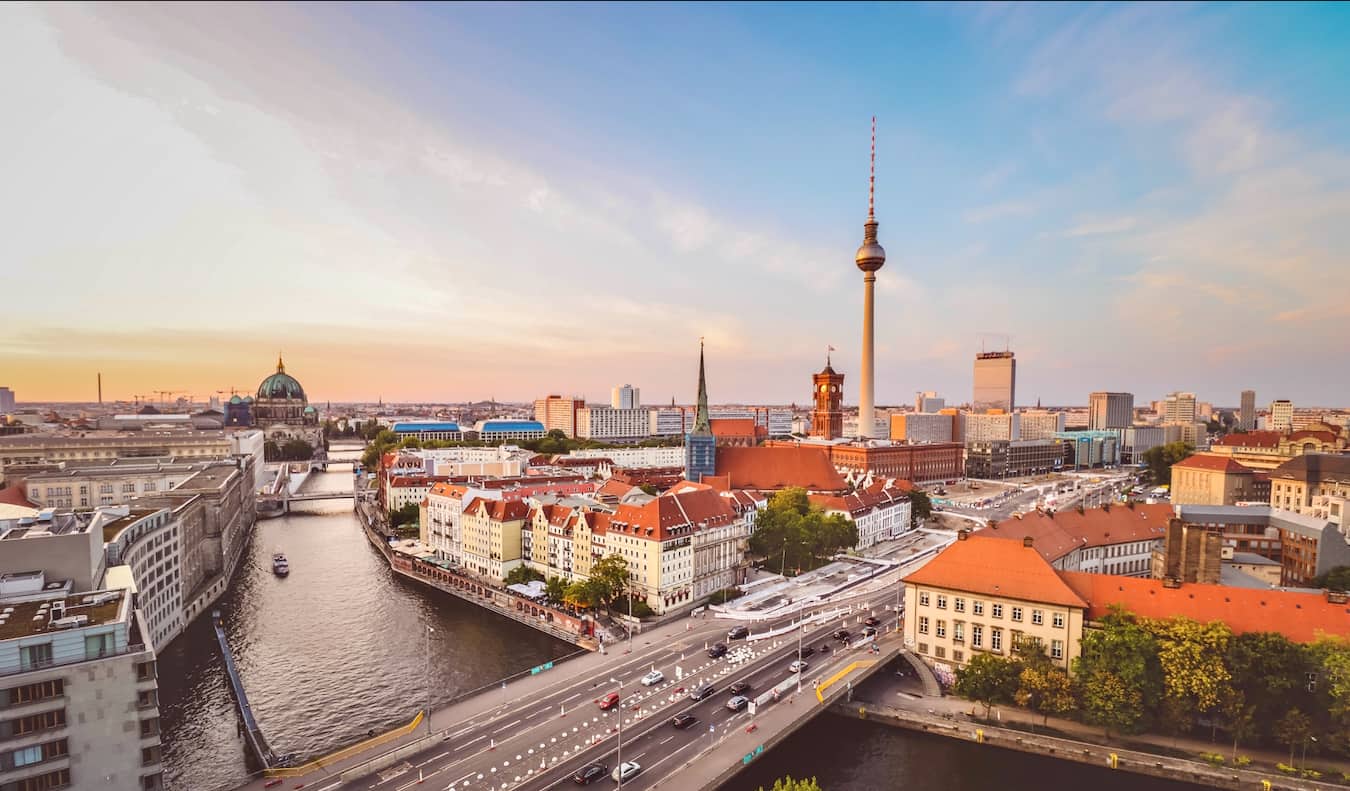
Last Updated: 1/8/24 | January 8th, 2024
Berlin is one of the most lively, fun cities in Europe. Known for its arty vibe and rambunctious nightlife, it’s a popular city for budget travelers and backpackers alike.
It’s also a diverse city with a ton of things to see and do. In fact, when I first visited the city I thought I’d be able to see everything in a few days.
But I was wrong. I barely scratched the surface.
Boasting sprawling street art, beautiful historic monuments, world-class museums, and cool bars and clubs, Berlin is a city that never disappoints. No matter what you’re looking for, you’ll find it here.
To help you save time, save money, and make the most of your visit, here is my list of the best things to do in Berlin:
1. Stroll down the East Side Gallery
When the Berlin Wall came down, a giant section was left standing, and artists were invited to paint a section of it that represented hope and violence. Now, the East Side Gallery is one of the best outdoor art exhibits in Berlin, featuring 105 paintings by artists from all over the world. Most of the pieces are political in nature, and I was really moved by some of the paintings. Learn more about the wall, artwork, and history via the signs posted along the length of the wall.
Muehlenstreet 6, +49 172 3918726, eastsidegallery-berlin.de. Entry is free.
2. Take a Free Walking Tour
One of the first things I do when I arrive in a new city is take a free walking tour. It’s the best way to get the lay of the land and connect with an expert local guide who can answer my questions. New Europe runs a long and informative walking tour that begins at the Brandenburg Gate and lasts 3.5 hours. It takes you through the center of the city, shows you all the highlights, gives you some history, and will help you orient yourself. Just remember to tip your guide at the end!
If you’d prefer to do a paid tour, there are all kinds of options available. One of my favorites is this in-depth Third Reich and Cold War tour that lasts two hours and dives deep into the city’s brutal and turbulent past.
Don’t skip it.
3. See the Brandenburg Gate
Built in 1791 by Prussian king Frederick William II, Brandenburg Gate is undoubtedly Berlin’s most famous landmark. It was built over the old city gate so that the route to the Prussian palace looked more opulent and impressive.
During the Cold War, the Brandenburg Gate was in no man’s land behind the Berlin Wall. When the Wall fell, everyone flocked to celebrate here and the gate has remained a symbol of a unified Germany ever since. It’s located in the Mitte neighborhood, just one block from the Reichstag building. If you want photos without people, come early.
4. Explore the Jewish History Museum
Jews have faced a long and hard road in Germany. They represented an important part of the population even though they were highly discriminated against. This museum traces the arrival of Jews and their contributions throughout German history, as well as the hardships they faced. It doesn’t go into much depth on the Holocaust, as there is a wonderful separate museum for that.
Like all museums in Germany, this is huge and will require a few hours to properly explore. Make sure you get a skip-the-line ticket in advance so you can beat the crowds. The line gets really long, especially during peak season, and they often sell out.
Lindenstreet 9-14, +49 30 25993300, jmberlin.de. Open daily from 10am-7pm. Admission to the main exhibitions is free, while a ticket to the temporary exhibitions is 8 EUR.
5. See the Holocaust Memorial
Located in Mitte near the Reichstag, The Memorial to the Murdered Jews of Europe is made up of concrete slabs designed to create a feeling of confusion and unease as you wander through them. Below is a museum that chronicles the Nazis’ treatment and extermination of the Jews by following various families throughout the Holocaust. It creates a very personalized and moving way to learn about this awful blight on human history, where over 6 million people were murdered in concentration camps alone.
Located near the Brandenburg Gate, +49 30 2639430, holocaust-mahnmal.de. Entry to the memorial is free.
6. Hang out in Treptower Park
Located in the eastern part of Berlin, this park is near an old abandoned amusement park (which you can also visit). It’s a popular place to bike around, and there are a number of beer gardens and a small island nearby where they have a weekend flea market. Moreover, you can rent boats and canoes and cruise down the Spree River. It’s my favorite park in the city. Don’t miss the Inselgarten beer garden with its giant bar swings and random tango classes.
Alt-Treptow, +49 30 25002333. Open 10am-1am.
7. Relax in Tempelhof Field
Located in the southern part of the city, this park is actually the site of the old airport used during the Berlin Airlift after World War II, when the Soviets tried to blockade Berlin. The airport finally closed in 2008, but the park has a lot of plaques and information so that you can learn more about the old airport. You can also take guided tours of the building in English to dive even deeper and see the inside for yourself.
The huge park itself is a favorite with Berliners, with lots of people running, working out, cycling, skateboarding, roller-blading, and flying kites here. In the summer, people take over the barbecue pits. The 3 park entrances are open from sunrise to sunset.
Ehemaliger Flufhafen Tempelhof, +49 30 7009060, thf-berlin.de/en. There are official tours in English every day (except Tuesdays) for 17.50 EUR (weekday tours are at 1:30pm and weekend tours are 1:30pm and 2:30pm). Entrance to the park is free.
8. Tour the German History Museum
This museum covers everything from prehistory right up to the present day. There are numerous in-depth exhibits here, so schedule a few hours to see it all. It’s one of my favorite history museums in the world because it is very, very detailed. Highlights include a 3.5-meter-tall coat of arms column from 1486, Napoleon’s hat from the battle of Waterloo in 1815, and a personal computer from East Germany.
Under the Linden 2, +49 30 203040, dhm.de. Opening hours vary by building. Admission is 10 EUR.
9. Visit the DDR Museum
The Deutsche Demokratische Republik museum focuses on life in East Berlin, with many interactive exhibits, including a simulated drive in an original Trabant P601 car. The museum is separated into the various aspects of daily life: food, clothing, schooling, fun, music, etc. It provides a good window into how the citizens of East Berlin (the Communist side) lived. One thing I found interesting was that to escape the conformity of life under Communism, it was normal for people to go to nude beaches.
Karl-Liebknecht-Street 1, +49 30 847123730, ddr-museum.de. Open daily from 9am-9pm. Admission is 13.50 EUR. /em>
10. Hang out in Tiergarten
Berlin’s central park is an excellent place to relax, walk, bike, and hang out. It’s one of the most beautiful city parks in all of Europe, in my opinion. Founded in 1527 as a private hunting ground for Germany’s ruling class, Tiergarten first opened to the public in 1740. While the park was significantly damaged during World War II, today, the park has been restored, with over 520 acres to explore.
Visitors can see the war memorial for Russian soldiers, the nearby Reichstag (Germany’s Parliament), and continue onwards to the famous Brandenburg Gate. There’s also (naturally) a popular beer garden in the park to kick back and relax for a bit.
11. See Checkpoint Charlie
This is the infamous gateway between former East and West Berlin. There’s a reconstruction of the checkpoint here, complete with fake soldiers (and lots of tourists taking pictures). The nearby museum was created in 1963 by Rainer Hildebrandt. It has a lot of pictures, information, and videos about people’s attempts to flee the East.
A word of caution, though: the museum is really tiny, making it hard to maneuver around due to the big crowds. Avoid going in the afternoon and on weekends.
Friedrichstraße 43-45, +49 30 2537250. The checkpoint itself is open every day and free to the public, while the museum is open Monday-Sunday from 10am-8pm. Admission to the museum is 17.50 EUR.
12. Take a boat tour
The Spree River, which stretches around 400 kilometers (250 miles), flows through Berlin, and there are lots of canals and waterways on which you can take a boat tour. Most cover all the main landmarks and include an audio guide too so you can learn a little as you take in the view. Scenic boat tours start at 21 EUR for a one-hour cruise. It’s a relaxing way to rest your feet after a busy day of exploring.
13. Hang out on “the beach”
A great summertime activity involves hanging out on “the beach.” Various areas of the riverbank (especially across from the main train station) have “beach bars” where people lounge in beach chairs, drink beer, and soak up the sun. Strandbad Wannsee on the outskirts of the city is especially popular for its sandy beaches and swimming areas.
14. Visit the Topography of Terror
This museum is on the spot where the SS and the Reich Security Main Office were located during World War II. It documents the terror and horror of the Nazi regime with harrowing video interviews with survivors, historical documents, photographs, and more. It also consists of excavated prison cells that were located under a remaining stretch of the Berlin Wall.
Niederkirchnerstraße 8, +49 30 2545090, topographie.de. Open daily from 10am-8pm. Admission is free. One-hour guided tours are available.
15. See the Reichstag
The seat of the Bundestag (German Parliament) is one of Berlin’s most historic landmarks. Opened in 1894, it has a clear dome to promote “transparency” in the government and is one of the most popular (read: crowded) attractions in Berlin. It fell into disuse and disrepair after World War II and wasn’t actually used again until 1999. From the dome, enjoy panoramic views over the city and learn about the parliament’s history from the interior exhibitions.
To make the most of your visit, take a guided tour. You’ll skip the line and learn about what you are seeing. I would recommend doing this over seeing it by yourself.
Platz der Republik 1, +49 30 22732152, bundestag.de/en. Admission is free (advance reservations required). Bring your passport as it’s required for entry!
16. Admire the Berliner Dom
The biggest and most impressive cathedral in Berlin, The Berliner Dom was built at the turn of the 20th century as an expression of imperial power. It’s located next to the museum island in Mitte and you can climb to the top of the dome for a beautiful view over Berlin’s center. While most visitors just stop by the outside for photos, the ornate interior decked in marble and onyx is worth a visit as well. Marvel at the massive 7,269-pipe organ and royal sarcophagi.
Am Lustgarten, +49 30 20269136, berlinerdom.de. You can visit The Dom daily. Open Monday-Friday from 9am-6pm, Saturdays from 9am-5pm, and Sundays from 12pm-5pm. It is also closed during services and ceremonies. Admission is 10 EUR.
17. Tour the Berliner Unterwelten-Museum
This guided tour takes you into the tunnel systems beneath the city, where you’ll find bunkers, air-raid shelters, and other remnants from the wars that have touched the city. There are four different tours to choose from depending on your area of interest. After the tour, you can view the small exhibition, and then descend into the basement of the BerlinerKindl brewery to sample some of their beers.
Brunnenstraße 105, +49 30 49910517, berliner-unterwelten.de/en. Open Monday–Sunday, 10:30am-4pm. Tours cost 16 EUR.
18. Hang out in Friedrichshain’s Markthalle Neun
If you’ve had your fill of Berliner currywurst and döner kebap and you’re looking for more variety, this huge food hall is a cool place to hang out during the day as it carries fresh produce, deli items, and handmade bread, pasta, and more. There are also various international-themed eateries as well. The regular weekly market is open Tuesday to Sunday until 6pm. Thursdays they have special street food where you can get Tibetan momos, British pies, tacos, Kässpatzen (dumplings with cheese), and more. They even have a selection of craft beer, wines, coffee, and other items to drink.
I’ll be honest: the first time I visited Berlin I didn’t see what the fuss was about the first time. But, after another visit, the city grew on me. Sure, it’s not as picturesque as Paris or London but the art, the music, and the food make it an energetic and happening place to be. Though I may not ever live here, I’d happily go back and visit — over and over again!
Get Your In-Depth Budget Guide to Europe!
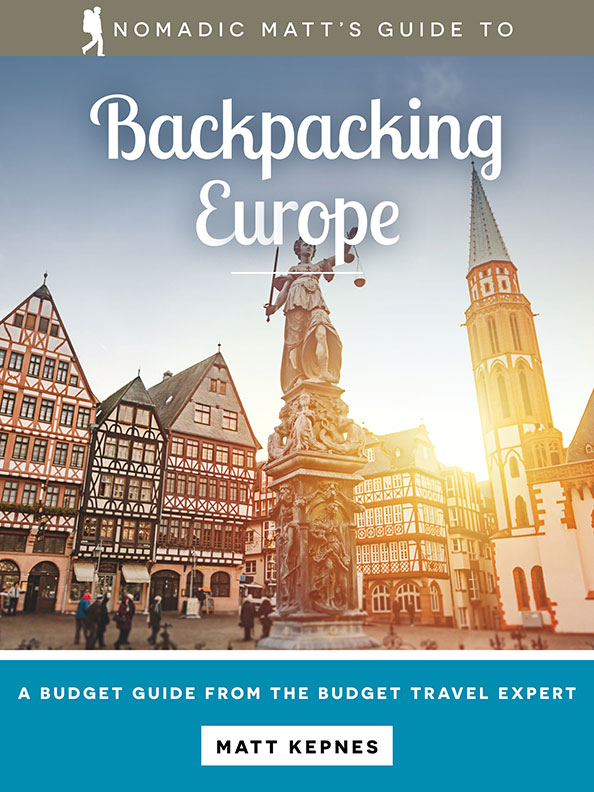
My detailed 200+ page guidebook is made for budget travelers like you! It cuts out the fluff found in other guides and gets straight to the practical information you need to travel while in Europe. It has suggested itineraries, budgets, ways to save money, on and off the beaten path things to see and do, non-touristy restaurants, markets, bars, safety tips, and much more! Click here to learn more and get your copy today.
Book Your Trip to Berlin: Logistical Tips and Tricks
Book Your Flight
Use Skyscanner to find a cheap flight. They are my favorite search engine because they search websites and airlines around the globe so you always know no stone is left unturned!
Book Your Accommodation
You can book your hostel with Hostelworld as they have the biggest inventory and best deals. If you want to stay somewhere other than a hostel, use Booking.com as they consistently return the cheapest rates for guesthouses and cheap hotels. Two of my favorite places to stay are:
If you’re looking for more places to stay, here’s a longer list of my favorite hostels in Berlin.
Don’t Forget Travel Insurance
Travel insurance will protect you against illness, injury, theft, and cancellations. It’s comprehensive protection in case anything goes wrong. I never go on a trip without it as I’ve had to use it many times in the past. My favorite companies that offer the best service and value are:
- Safety Wing (best for everyone)
- Insure My Trip (for those over 70)
- Medjet (for additional evacuation coverage)
Looking for the Best Companies to Save Money With?
Check out my resource page for the best companies to use when you travel. I list all the ones I use to save money when I’m on the road. They will save you money when you travel too.
Want More Information on Berlin?
Be sure to visit our robust destination guide on Berlin for even more planning tips!
